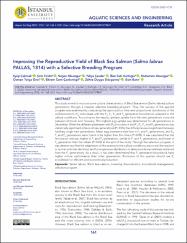Improving the reproductive yield of Black Sea Salmon (Salmo labrax PALLAS, 1814) with a selective breeding program

Göster/
Erişim
info:eu-repo/semantics/openAccessTarih
2022Yazar
Çakmak, EyüpFiridin, Şirin
Aksungur, Nilgün
Çavdar, Yahya
Kurtoğlu, İlker Zeki
Aksungur, Muharrem
Özel, Osman Tolga
Çankırılıgil, Ekrem Cem
Düzgünses, Zehra Duygu
Batır, Esin
Üst veri
Tüm öğe kaydını gösterKünye
Çakmak, E., Firidin, Ş., Aksungur, N., Çavdar, Y., Kurtoğlu, İ.Z., Aksungur, M., Özel, O.T., Çankırılıgil, E., Düzgüneş, Z.D., & Batır, E. (2022). Improving the Reproductive Yield of Black Sea Salmon (Salmo labrax PALLAS, 1814) with a Selective Breeding Program. Aquatic Sciences and Engineering, 37(3), 161-168. https://doi.org/10.26650/ASE20221079847Özet
This study aimed to improve some culture characteristics of Black Sea salmon (Salmo labrax) culture generations through a classical selective breeding program. Thus, the success of the applied program was examined by comparing the reproduction time and proportional distribution of the wild broodstock (F-0) individuals with the F-1, F-2, F-3 and F-4 generation broodstocks adapted to the culture conditions. According to the results, gamete uptake from the new generations occurred between October and February. The highest egg uptake was determined for all generations in December. While the difference between wild (F-0) broodstock and F-1, F-2, F-3, and F-4 generations was statistically significant in favor of new generations (P<0.05), the difference was insignificant between hatchery origin-new generations. Mean egg diameters were low in F-2 and F-3 generations, and F-0, F-1 and F-4 generations were found to be higher than the others (P<0.05). It was calculated that the fertilization rate was higher in F-3 and F-4 generations, similar in F-1 and F-2 generations, and lower in F-0 generation than the others (P<0.05) at the end of the study. Through the selection program, it was determined that the adaptation of the species to the culture conditions improved, the reaction to human activities declined, and homogeneous distribution in tanks/ponds was relatively achieved from the F-2 generations. As a result, it has been determined that F-4 generation broodstock have higher culture performance than other generations. Producers of this species should use F-4 broodstock for efficient and economical production.

















